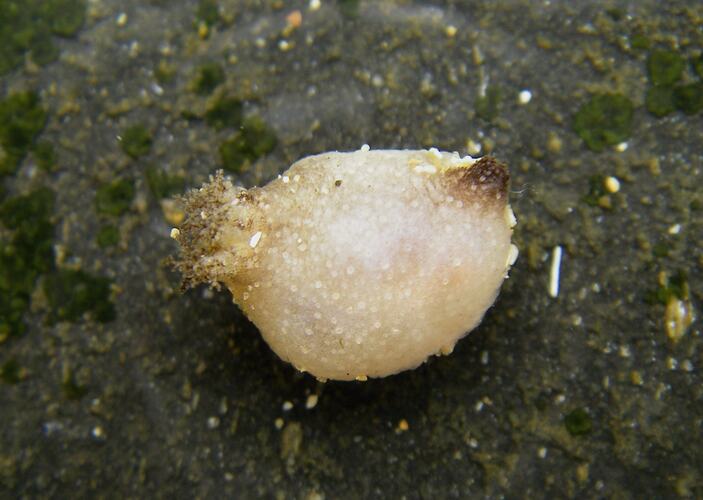General Description
Soft, rounded body with upturned oral and anal ends and distinct ventral sole; body off-white to pale or dark brown; 10 dendritic tentacles, ventral 2 smaller; 5 anal scales; body wall thin, covered by small tube feet and often sand/algae; sole oval, thin-walled and off-white with tube feet in 3 radial series; body wall ossicles concave knobbed crosses, cups, smooth buttons, and thick perforated plates; sole ossicles abundant cups and thickened plates, rare crosses and buttons; up to ~20 mm long and 11 mm wide.
Biology
Psolidiella hickmani uses its ventral tube-feet to attach to and crawl along rocks and algae. It also holds sand and algal fragments with its dorsal and lateral tube feet to provide camouflage. It feeds using tree-like branching tentacles (dendritic tentacles) that extend into the surrounding water to collect organic particles which are then fed back to the mouth.
Psolidiella hickmani has a specialized adaptation in the form of anterior interradial marsupia. Females brood-protect their eggs and embryos in these individual 'neck pouches' around the oral cone. This leads to sexual dimorphism (the sexes looking different from each other) in the species as males have smooth oral cones, while females have wrinkled/folded cones to accommodate these oral pouches/pockets. From October to April these pouches hold differentiating embryos up to 0.5 mm long. There is some evidence that adults of Psolidiella hickmani in Tasmania are larger than those in Victoria and hold a greater number of bood-protected embryos.
Distribution
South-eastern Australia, from west of Wilsons Promontory in Victoria to Robe in South Australia and also southern Tasmania.
Habitat
Temperate reefs. In seaweed, around and under rocks, often in infralittoral fringe, to depth of at least 6 m
More Information
-
Animal Type
-
Animal SubType
-
Fast Fact
Females of this small sea cucumber species have marsupia in the form of wrinkled or pocket-like 'neck pouches' used to brood protect their babies.
-
Brief Id
Soft, rounded body with distinct sole, pale to dark brown, 10 dendritic tentacles, covering of tube feet and often sand and algae.
-
Maximum Size
2 cm
-
Habitats
-
Diet
Organic matter
-
Endemicity
-
Depths
Shore (0-1 m), Shallow (1-30 m)
-
Water Column Locations
On or near seafloor
-
Taxon Name
-
Scientific Author
O'Loughlin, 2000
-
Common Name
Sea Cucumber
-
Phylum
-
Class
-
Order
-
Family
-
Genus
-
Species Name
hickmani

